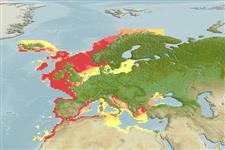Common names from other countries
Elasmobranchii (haaien en roggen) (sharks and rays) >
Rajiformes (Skates and rays) >
Rajidae (Skates)
Etymology: Leucoraja: Greek, leykos = white + Latin, raja = a fish, Raja sp. (Ref. 45335).
More on author: Linnaeus.
Environment: milieu / Klimaatzone / Diepte / distribution range
Ecologie
marien bathydemersaal; diepte 30 - 600 m (Ref. 106604). Deep-water; 72°N - 27°N, 24°W - 34°E
Eastern Atlantic: Murmansk in Russia, Norway, southern Iceland, the Faroes, northern North Sea and Skagerrak to northern Morocco, including western Mediterranean and the Madeira Islands.
Lengte bij maturiteit / Grootte / Gewicht / Leeftijd
Maturiteit: Lm ?, range 75 - ? cm
Max length : 120 cm TL mannelijk / geslacht onbekend; (Ref. 106604); 111.0 cm TL (female)
Dorsale stekels (totaal) : 0; Anale stekels: 0. Snout pronounced, rather pointed; disc rhomboid, with angled outer corners upper surface entirely spinulose, underside prickly on large areas; about 8 thorns usually in a complete row around inner margin of eye, small thorns on scapular, generally a row of about 50 thorns on each side of midline from shoulder to first dorsal fin; upper surface plain ashy-grey, underside white (Ref. 3167).
Body shape (shape guide): other; Cross section: flattened.
Found in relatively cold coastal waters and on upper parts of continental slopes (Ref. 3167). Most common at depths of around 200 m, but deeper in southern areas (Ref. 3167); possibly down to 800 m (Ref. 131089). Feed on all kinds of bottom animals, probably preferring fish (Ref. 3167). Oviparous. Distinct pairing with embrace. Young may tend to follow large objects, such as their mother (Ref. 205). Eggs are oblong capsules with stiff pointed horns at the corners deposited in sandy or muddy flats (Ref. 205). Egg capsules are 7.5-9.9 cm long and 4.5-4.7 cm wide (Ref. 41250). Maximum length for female is 111 cm (Ref. 41333).
Levenscyclus en paargedrag
Maturiteit | Voortplanting | Paaien | Eieren | Fecunditeit | Larven
Oviparous, paired eggs are laid. Embryos feed solely on yolk (Ref. 50449). Distinct pairing with embrace. Young may tend to follow large objects, such as their mother (Ref. 205).
McEachran, J.D. and K.A. Dunn, 1998. Phylogenetic analysis of skates, a morphologically conservative clade of elasmobranchs (Chondrichthyes: Rajidae). Copeia 1998(2):271-290. (Ref. 27314)
Status op de Rode Lijst van het IUCN (Ref. 130435: Version 2025-1)
Gevaar voor de mens
Harmless
Gebruik door de mens
Visserij: van minder commercieel belang
Tools
Speciale rapporten
Download XML
Internetbronnen
Estimates based on models
Preferred temperature (Ref.
123201): 6.8 - 14.5, mean 9.5 °C (based on 370 cells).
Fylogenetische diversiteitsindex (Ref.
82804): PD
50 = 0.5000 [Uniqueness, from 0.5 = low to 2.0 = high].
Bayesian length-weight: a=0.00339 (0.00168 - 0.00685), b=3.25 (3.08 - 3.42), in cm total length, based on LWR estimates for this Genus-body shape (Ref.
93245).
Trofisch niveau (Ref.
69278): 3.5 ±0.37 se; based on food items.
Weerstandsvermogen (Ref.
120179): laag, minimale populatieverdubbelingstijd 4,5-14 jaar (Assuming tm>5).
Fishing Vulnerability (Ref.
59153): High to very high vulnerability (72 of 100).
🛈
Climate Vulnerability (Ref.
125649): Moderate vulnerability (38 of 100).
🛈
Nutrients (Ref.
124155): Calcium = 3.69 [0.55, 69.61] mg/100g; Iron = 0.283 [0.028, 3.709] mg/100g; Protein = 15.3 [13.2, 17.3] %; Omega3 = 0.379 [0.153, 0.945] g/100g; Selenium = 16.4 [3.0, 77.0] μg/100g; VitaminA = 3.67 [0.27, 48.17] μg/100g; Zinc = 0.269 [0.018, 3.165] mg/100g (wet weight);
